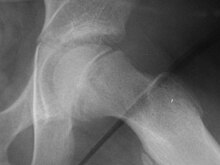Klein's line
| Line of Klein | |
|---|---|
 | |
| Radiogram of slipped capital femoral epiphysis |
Klein's line or the line of Klein is a virtual line that can be drawn on an X-ray of an adolescent's hip parallel to the anatomically upper edge of the femoral neck. It was the first tool to aid in the early diagnosis of a slipped capital femoral epiphysis (SCFE), which if treated late or left untreated leads to crippling arthritis, leg length discrepancy and lost range of motion. It is named after the American orthopedic surgeon Armin Klein at Harvard University, who published its description and usefulness in 1952. Subsequent modification of its use has increased the sensitivity and reliability of the tool.
Description
Klein's line is a virtual line that can be drawn on an X-ray of a child's hip parallel to the upper edge of the femoral neck. If the line does not intersect with the outermost part of the femoral head 's ball-like end, the diagnosis of a slipped capital femoral epiphysis (SCFE) is confirmed.[1]
History
Klein's line is named after the orthopaedic surgeon Armin Klein (1892–1954), Chief of Orthopaedic Services at the then newly opened Beth Israel Hospital of Boston[2] for his observations presented to the American Academy of Orthopaedic Surgeons in 1951 and published in 1952.[3] Klein and three colleagues at Massachusetts General Hospital had seen the crippling effects in later life for a person with slipped capital femoral epiphysis; they were convinced that early diagnosis in childhood and "prophylactic procedures" were needed to treat the condition.[3]: 233 The diagnosis was up until then made by comparing the X-ray of the suspected epiphysis with the "normal" hip on the opposite side, which in Klein's series had left 11 of 38 children undiagnosed.[3]: 234 In children with the condition they observed an abnormal alignment of the femoral head with the femoral neck on an X-ray taken from a frontal view of the hip joint and a side view taken with the child in the frog-leg position: "The proximal part of the femoral neck at its juncture with the epiphysis was left bare superiorly and anteriorly over an area equivalent to the amount of slipping of the head as much as in the 'normal' hip."[3]: 238
Usefulness
As early as 1957,[4] throughout the 1960s,[5] and into the end of the 20th century[6] surgeons have remarked on the number of missed diagnoses using the Klein's line.
In 2009, the classic definition of Klein's line was shown to miss 60% of SCFE cases on X-rays of 30 children between 8 and 16 years of age.[1] The sensitivity and reliability is improved by measuring the epiphyseal width lateral to Klein's line, which if differing by 2 millimetres (0.079 in) or more between hips suggests the diagnosis of SCFE.[1]
See also
References
- ^ a b c Green DW, Mogekwu N, Scher DM, Handler S, Chalmers P, Widmann RF (2009). "A modification of Klein's Line to improve sensitivity of the anterior-posterior radiograph in slipped capital femoral epiphysis". J Pediatr Orthopedics. 29 (5): 449–453. doi:10.1097/BPO.0b013e3181aa20cd. PMID 19568015. S2CID 25529620.
- ^ "Armin Klein 1892–1954". J Bone Joint Surg Am. 36 (4): 886–887. Jul 1954. doi:10.2106/00004623-195436040-00029.
- ^ a b c d Klein A, Joplin RJ, Reidy JA, Hanelin J (1952). "Slipped capital femoral epiphysis; early diagnosis and treatment facilitated by normal roentgenograms". J Bone Joint Surg Am. 34 A: 233–239. doi:10.2106/00004623-195234010-00033. PMID 14907813.
- ^ Burrows HJ (1957). "Slipped upper femoral epiphysis; characteristic of a hundred cases". J Bone Joint Surg Br. 39B (4): 641–658. doi:10.1302/0301-620X.39B4.641. PMID 13491627.
- ^ Cowell HR (1966). "The significance of early diagnosis and treatment of slipping of the capital femoral epiphysis". Clin Orthop Relat Res. 48: 89–94. PMID 5958576.
- ^ Matava MJ, Patton CM, Luhmann S, et al. (1999). "Knee pain as the initial symptom of slipped capital femoral epiphysis: an analysis of initial presentation and treatment". J Pediatr Orthop. 19 (4): 455–460. doi:10.1097/01241398-199907000-00007. PMID 10412993.